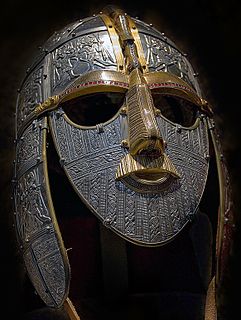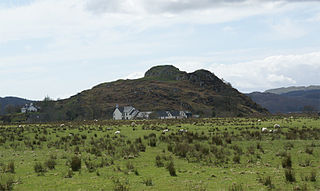 W
WScotland was divided into a series of kingdoms in the early Middle Ages, i.e. between the end of Roman authority in southern and central Britain from around 400 CE and the rise of the kingdom of Alba in 900 CE. Of these, the four most important to emerge were the Picts, the Gaels of Dál Riata, the Britons of Alt Clut, and the Anglian kingdom of Bernicia. After the arrival of the Vikings in the late 8th century, Scandinavian rulers and colonies were established on the islands and along parts of the coasts. In the 9th century, the House of Alpin combined the lands of the Scots and Picts to form a single kingdom which constituted the basis of the kingdom of Scotland.
 W
WThe Anglo-Saxon settlement of Britain is the process which changed the language and culture of most of what became England from Romano-British to Germanic. The Germanic-speakers in Britain, themselves of diverse origins, eventually developed a common cultural identity as Anglo-Saxons. This process principally occurred from the mid-fifth to early seventh centuries, following the end of Roman rule in Britain around the year 410. The settlement was followed by the establishment of Anglo-Saxon kingdoms in the south and east of Britain, later followed by the rest of modern England, and the south-east of modern Scotland.
 W
WDál Riata or Dál Riada was a Gaelic kingdom that encompassed the western seaboard of Scotland and the north-eastern corner of Ireland, on each side of the North Channel. At its height in the 6th and 7th centuries, it covered what is now Argyll in Scotland and part of County Antrim in Northern Ireland. After a period of expansion, Dál Riata eventually became associated with the Gaelic Kingdom of Alba.
 W
WDunadd is a hillfort dating from the Iron Age and early medieval period in Kilmichael Glassary in Argyll and Bute, Scotland and believed to be the capital of the ancient kingdom of Dál Riata. Dal Riata, as a kingdom, appeared in Argyll in the early centuries AD, after the Romans had abandoned Scotland. Rulers of Argyll were Gaelic speakers. Dunadd is a hill on which they built a citadel.
 W
WHinba is an island in Scotland of uncertain location that was the site of a small monastery associated with the Columban church on Iona. Although a number of details are known about the monastery and its early superiors, and various anecdotes dating from the time of Columba of a mystical nature have survived, modern scholars are divided as to its whereabouts. The source of information about the island is Adomnán's late 7th-century Vita Columbae.
 W
WThe Kingdom of Ce was a legendary ancient Pictish kingdom in Scotland. The author of the Pictish Chronicle records that the kingdom was formed after the division of Alba among the seven sons of Cruithne. Ce was the first and eponymous king, and his reign lasted fifteen years. Some sources dispute this, giving him a reign of eleven, twelve or twenty years. The kingdom of Ce encompassed Banff, Buchan, and other areas of Aberdeenshire, such as the region now known as Mar.
 W
WStrathclyde, originally Cumbric: Ystrad Clud or Alclud, was one of the early medieval kingdoms of the Britons in what the Welsh call Hen Ogledd, the Brythonic-speaking parts of what is now southern Scotland and northern England. The kingdom developed during the post-Roman period. It is also known as Alt Clut, a Brittonic term for Dumbarton Castle, the medieval capital of the region. It may have had its origins with the Brythonic Damnonii people of Ptolemy's Geography.
 W
WThe origins of the Kingdom of Alba pertain to the origins of the Kingdom of Alba, or the Gaelic Kingdom of Scotland, either as a mythological event or a historical process, during the Early Middle Ages.
 W
WThe Riasg Buidhe Cross is a cross standing in the gardens of Colonsay House on the Inner Hebridean island of Colonsay, Scotland. It takes its name from the now abandoned and ruined village of Riasg Buidhe about 1.5 miles to the south-east of Colonsay House, where it was found in the nineteenth century.
 W
WRubers Law is a prominent, conical hill in the Scottish Borders area of south-east Scotland. It stands on the south bank of the River Teviot, between the towns of Hawick and Jedburgh, and south of the village of Denholm. The hill is on the border between the historic parishes of Cavers and Hobkirk, and until 1975 it stood within the historic county of Roxburghshire.
 W
WVitrified forts are stone enclosures whose walls have been subjected to vitrification through heat. It was long thought that these structures were unique to Scotland, but they have since been identified in several other parts of western and northern Europe.